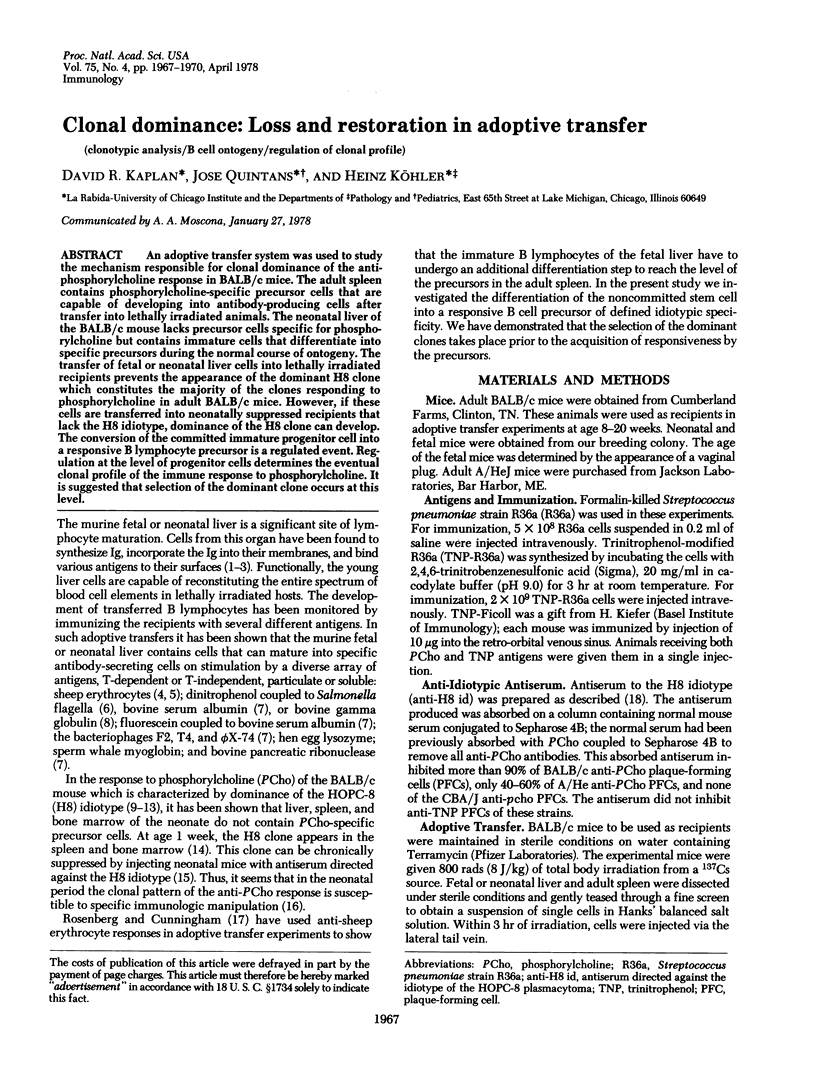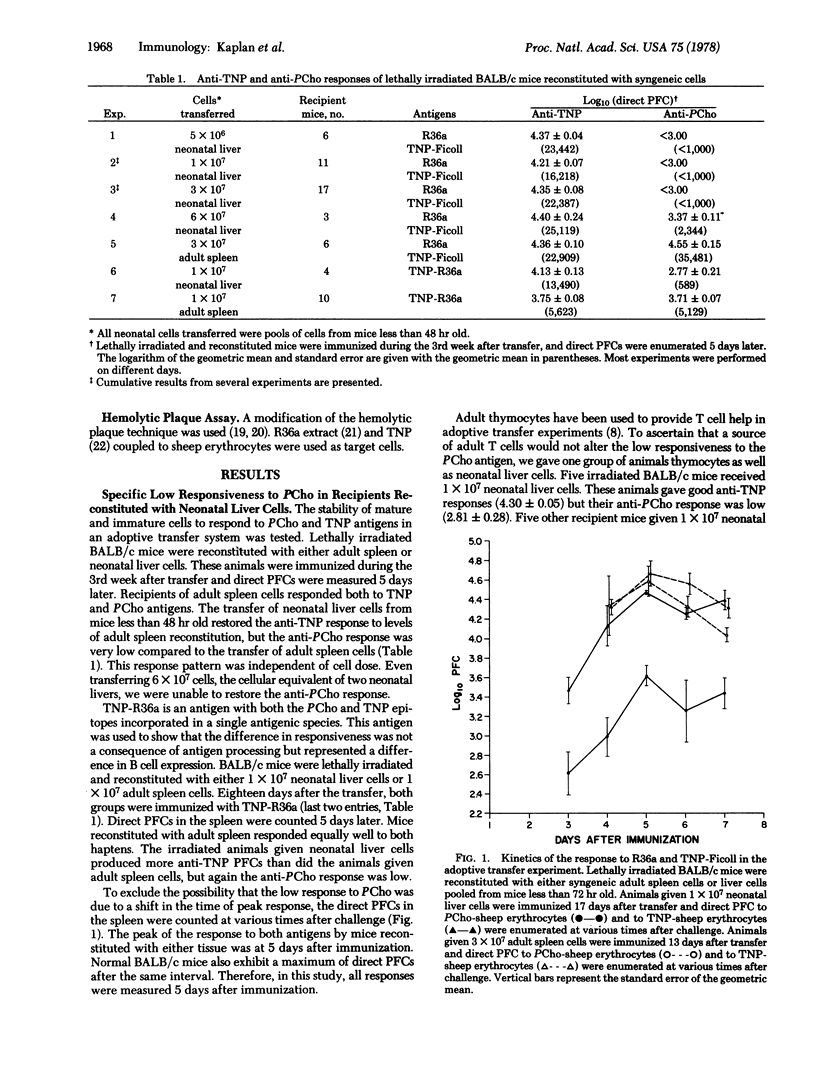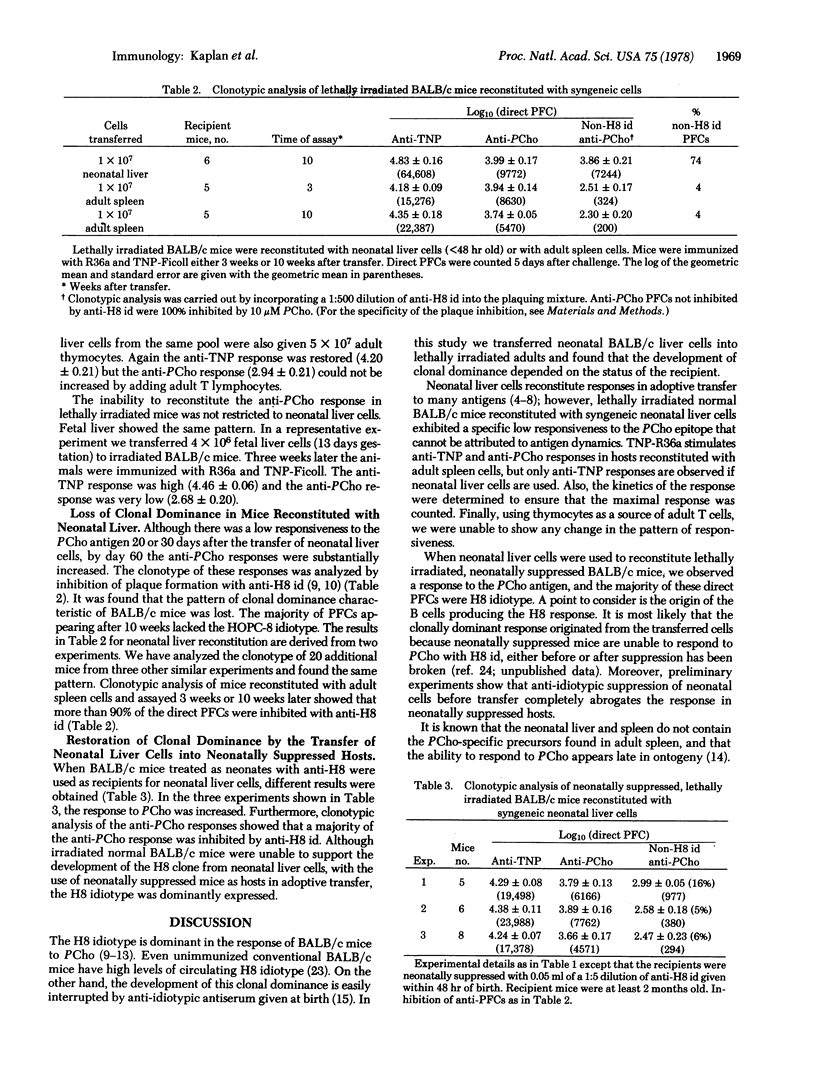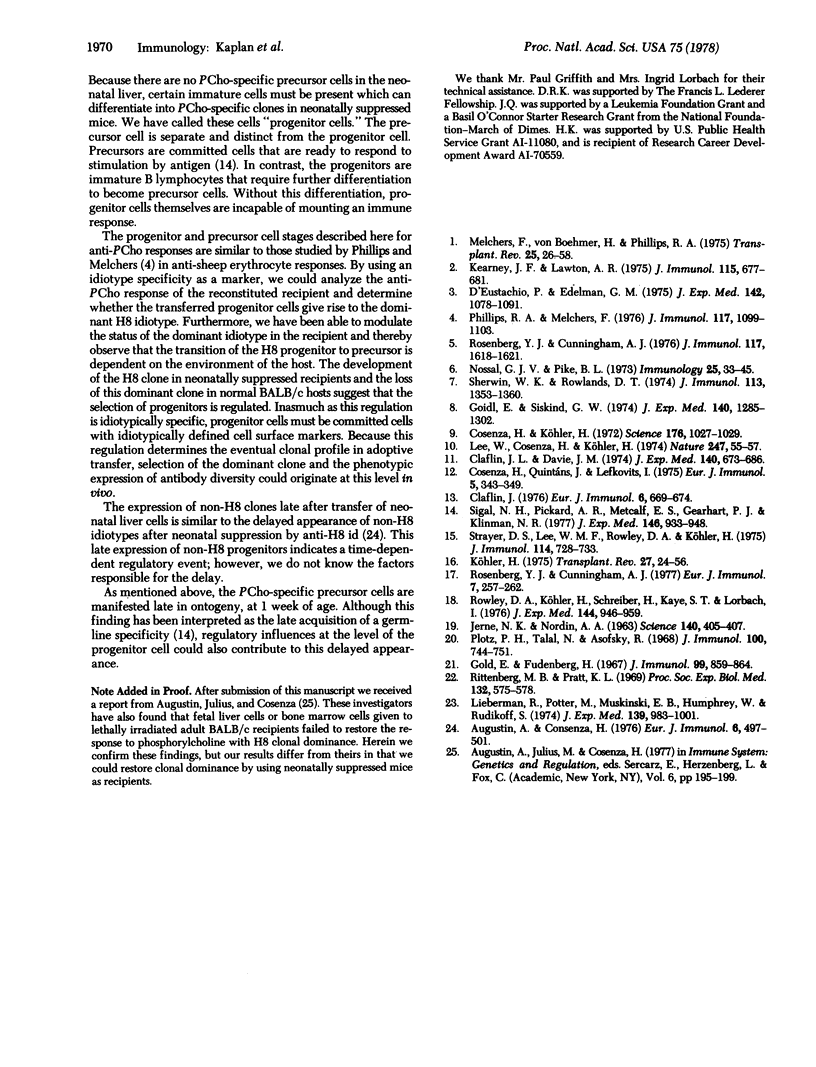Abstract
An adoptive transfer system was used to study the mechanism responsible for clonal dominance of the anti-phosphorylcholine response in BALB/c mice. The adult spleen contains phosphorylcholine-specific precursor cells that are capable of developing into antibody-producing cells after transfer into lethally irradiated animals. The neonatal liver of the BALB/c mouse lacks precursor cells specific for phosphorylcholine but contains immature cells that differentiate into specific precursors during the normal course of ontogeny. The transfer of fetal or neonatal liver cells into lethally irradiated recipients prevents the appearance of the dominant H8 clone which constitutes the majority of the clones responding to phosphorylcholine in adult BALB/c mice. However, if these cells are transferred into neonatally suppressed recipients that lack the H8 idiotype, dominance of the H8 clone can develop. The conversion of the committed immature progenitor cell into a responsive B lymphocyte precursor is a regulated event. Regulation at the level of progenitor cells determines the eventual clonal profile of the immune response to phosphorylcholine. It is suggested that selection of the dominant clone occurs at this level.
Full text
PDF



Selected References
These references are in PubMed. This may not be the complete list of references from this article.
- Augustin A., Cosenza H. Expression of new idiotypes following neonatal idiotypic suppression of a dominant clone. Eur J Immunol. 1976 Jul;6(7):497–501. doi: 10.1002/eji.1830060710. [DOI] [PubMed] [Google Scholar]
- Claflin J. L., Davie J. M. Clonal nature of the immune response to phosphorylcholine. IV. Idiotypic uniformity of binding site-associated antigenic determinants among mouse antiphosphorylcholine antibodies. J Exp Med. 1974 Sep 1;140(3):673–686. doi: 10.1084/jem.140.3.673. [DOI] [PMC free article] [PubMed] [Google Scholar]
- Claflin J. L. Uniformity in the clonal repertoire for the immune response to phosphorylcholine in mice. Eur J Immunol. 1976 Oct;6(10):669–674. doi: 10.1002/eji.1830061002. [DOI] [PubMed] [Google Scholar]
- Cosenza H., Köhler H. Specific inhibition of plaque formation to phosphorylcholine by antibody against antibody. Science. 1972 Jun 2;176(4038):1027–1029. doi: 10.1126/science.176.4038.1027. [DOI] [PubMed] [Google Scholar]
- Cosenza H., Quintáns J., Lefkovits I. Antibody response to phosphorylcholine in vitro. I. Studies on the frequency of precursor cells, average clone size and cellular cooperation. Eur J Immunol. 1975 May;5(5):343–349. doi: 10.1002/eji.1830050510. [DOI] [PubMed] [Google Scholar]
- D'Eustachio P., Edelman G. M. Frequency and avidity of specific antigen-binding cells in developing mice. J Exp Med. 1975 Nov 1;142(5):1078–1091. doi: 10.1084/jem.142.5.1078. [DOI] [PMC free article] [PubMed] [Google Scholar]
- Goidl E. A., Siskind G. W. Ontogeny of B-lymphocyte function. I. Restricted heterogeneity of the antibody response of B lymphocytes from neonatal and fetal mice. J Exp Med. 1974 Nov 1;140(5):1285–1302. doi: 10.1084/jem.140.5.1285. [DOI] [PMC free article] [PubMed] [Google Scholar]
- Gold E. R., Fudenberg H. H. Chromic chloride: a coupling reagent for passive hemagglutination reactions. J Immunol. 1967 Nov;99(5):859–866. [PubMed] [Google Scholar]
- JERNE N. K., NORDIN A. A. Plaque formation in agar by single antibody-producing cells. Science. 1963 Apr 26;140(3565):405–405. [PubMed] [Google Scholar]
- Kearney J. F., Lawton A. R. B lymphocyte differentiation induced by lipopolysaccharide. II. Response of fetal lymphocytes. J Immunol. 1975 Sep;115(3):677–681. [PubMed] [Google Scholar]
- Köhler H. The response to phosphorylcholine: dissecting an immune response. Transplant Rev. 1975;27:24–56. [PubMed] [Google Scholar]
- Lee W., Cosenza H., Köhler H. Clonal restriction of the immune response to phosphorylcholine. Nature. 1974 Jan 4;247(5435):55–57. doi: 10.1038/247055a0. [DOI] [PubMed] [Google Scholar]
- Lieberman R., Potter M., Mushinski E. B., Humphrey W., Jr, Rudikoff S. Genetics of a new IgVH (T15 idiotype) marker in the mouse regulating natural antibody to phosphorylcholine. J Exp Med. 1974 Apr 1;139(4):983–1001. doi: 10.1084/jem.139.4.983. [DOI] [PMC free article] [PubMed] [Google Scholar]
- Melchers F., Von Boehmer H., Phillips R. A. B-lymphocyte subpopulations in the mouse. Organ distribution and ontogeny of immunoglobulin-synthesizing and of mitogen-sensitive cells. Transplant Rev. 1975;25:26–58. doi: 10.1111/j.1600-065x.1975.tb00725.x. [DOI] [PubMed] [Google Scholar]
- Phillips R. A., Melchers F. Appearance of functional lymphocytes in fetal liver. J Immunol. 1976 Oct;117(4):1099–1103. [PubMed] [Google Scholar]
- Plotz P. H., Talal N., Asofsky R. Assignment of direct and facilitated hemolytic plaques in mice to specific immunoglobulin classes. J Immunol. 1968 Apr;100(4):744–751. [PubMed] [Google Scholar]
- Rittenberg M. B., Pratt K. L. Antitrinitrophenyl (TNP) plaque assay. Primary response of Balb/c mice to soluble and particulate immunogen. Proc Soc Exp Biol Med. 1969 Nov;132(2):575–581. doi: 10.3181/00379727-132-34264. [DOI] [PubMed] [Google Scholar]
- Rosenberg Y. J., Cunningham A. J. Ontogeny of the antibody-forming cell line in mice. II. Maturation of B cells during fetal development. J Immunol. 1976 Nov;117(5 Pt 1):1618–1621. [PubMed] [Google Scholar]
- Rosenberg Y. J., Cunningham A. J. Ontogeny of the antibody-forming cell line in mice. III. The generation of mature anti-sheep red blood cell-specific B cells is antigen-dependent. Eur J Immunol. 1977 May;7(5):257–263. doi: 10.1002/eji.1830070503. [DOI] [PubMed] [Google Scholar]
- Rowley D. A., Köhler H., Schreiber H., Kaye S. T., Lorbach I. Suppression by autogenous complementary idiotypes: the priority of the first response. J Exp Med. 1976 Oct 1;144(4):946–959. doi: 10.1084/jem.144.4.946. [DOI] [PMC free article] [PubMed] [Google Scholar]
- Sherwin W. K., Rowlands D. T., Jr Development of humoral immunity in lethally irradiated mice reconstituted with fetal liver. J Immunol. 1974 Oct;113(4):1353–1360. [PubMed] [Google Scholar]
- Sigal N. H., Pickard A. R., Metcalf E. S., Gearhart P. J., Klinman N. R. Expression of phosphorylcholine-specific B cells during murine development. J Exp Med. 1977 Oct 1;146(4):933–948. doi: 10.1084/jem.146.4.933. [DOI] [PMC free article] [PubMed] [Google Scholar]
- Strayer D. S., Lee W. M., Rowley D. A., Köhler H. Anti-receptor antibody. II. Induction of long-term unresponsiveness in neonatal mice. J Immunol. 1975 Feb;114(2 Pt 2):728–733. [PubMed] [Google Scholar]


